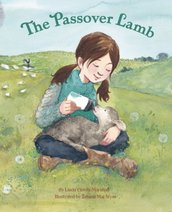The Passover Lamb
By Linda Elovitz Marshall; illustrated by Tatjana Mai-Wyss
32 pages, ages 6 - 9
Random House 2013
As Miriam scatters chicken feed and gathers eggs, she
practices chanting the questions she’ll ask tonight at Grandma’s house. “Ma
nishtana ha-laila ha-zeh…? Why is this night different from all other nights?
Of course, this is the day Snowball has her lambs –
triplets. She won’t nurse the smallest, so Miriam fills a bottle with special
milk for newborns and feeds the hungry lamb. But newborns need to be fed every
four hours - how can they go to seder?
Miriam wants to take part in the Passover meal where they
retell the story of how the Jews were slaves in Egypt. And how one mother hid
her baby, Moses, in a basket to….
“Hey!” she says, “I know what to do!”
Linda Marshall’s story is inspired by an actual event that
happened on her farm – when her children took a newborn lamb along with them to
seder. I was lucky enough to get Linda to answer Three Questions about her book.
Sally’s Bookshelf: Did you carry him in a basket?
Linda: It happened a long time ago, but as I recall, we
didn’t use a basket. Instead, the lamb sat on my kids’ laps or under the table
where he nibbled our toes as we told the stories. My kids named him “Moses” as
a gentle joke. And lamb nibbles? They feel soft and furry...and tickley.
SB: Your books focus on Jewish themes. Why?
Linda: Not all of my books focus on Jewish themes. But it’s only
recently that I began writing for children and, as it’s turned out, the books
that have been published so far have Jewish themes. My stories, though, are inspired by many things - from farm life
to word-plays to everyday mysteries like vacuum cleaners.
SB: The inspiration for many of your stories comes from
relatives or family stories. How do you craft universal stories from these -
what sort of process do you go through?
Linda: This is a great question; thank you for asking. I
think everyone has a different process for this, so I'll tell you what I try to
do – even though it doesn’t always work. First, I think about what actually
happened. Then, I ask myself what story do I want to tell? How can adapt (or
invent) story elements to build tension? Then I start writing. For me, the first draft is the hardest part
because I'm literally making “something from nothing.” When the first draft is finally written, I let it “simmer” in my
subconscious....That’s when I ponder what I call the “deep structure” of the
story – the thing that makes it universal. How does this particular vignette
speak to the human heart? The answers generally come while I'm driving or
swimming or in the shower. They don't come while I’m consciously thinking about
the story! When I finally understand my story’s deep structure, I try to put it
in context with other literature with a similar deep structure so I can learn
from what came before. And, if I can do that, I often have a much stronger
story. It’s a complicated process for what seems simple: a picture book – and
that’s only the beginning of the process.
Review copy from publisher.
Review copy from publisher.

No comments:
Post a Comment